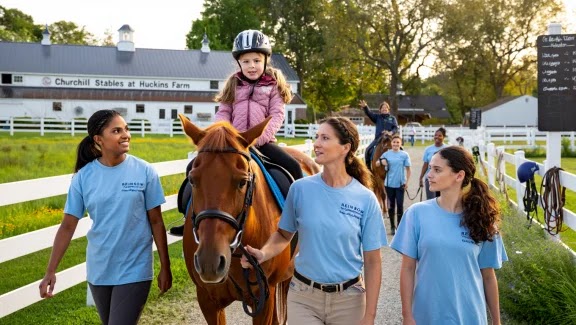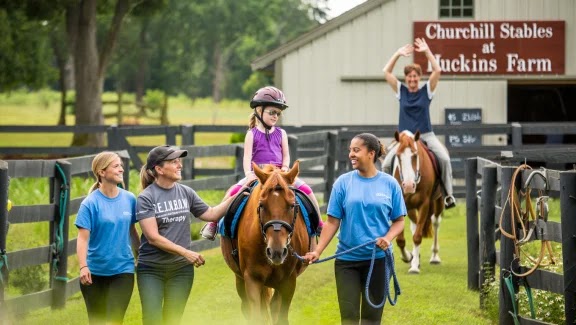The transformative power of equine therapy remains largely invisible to those who need it most – hidden behind clinical terminology, skepticism, and the challenge of articulating profound healing experiences that transcend simple explanation. For practitioners and centers offering these life-changing interventions, this communication gap creates a persistent barrier that keeps potential clients from experiencing therapeutic breakthroughs while limiting program growth and sustainability.
You’ve likely encountered this frustration yourself – struggling to convey the deep impact of horse-human connection to skeptical referral sources, or finding that traditional documentation methods fail to capture the subtle yet significant progress made during sessions. This disconnect between transformative experiences and the ability to communicate them effectively undermines both clinical outcomes and program viability.
The emerging solution embraced by forward-thinking equine therapy centers involves reimagining how these healing journeys are documented and shared. Programs partnering with specialized CRFT video production teams are discovering that strategic visual storytelling doesn’t merely supplement their communication efforts – it fundamentally transforms how referring professionals, clients, and families understand and engage with equine therapy in ways that traditional approaches simply cannot match.
The Unseen Progress: Why Traditional Documentation Fails Equine Therapy’s Subtle Evolution
Traditional progress documentation in therapeutic settings relies heavily on written assessments and verbal descriptions – methods profoundly inadequate for capturing the nuanced, nonverbal dimensions where equine therapy creates its deepest impact. This documentation gap explains why many remarkable client transformations remain functionally invisible to referring professionals, families, and even clients themselves.
The inherent limitations of text-based documentation become particularly pronounced in equine-assisted interventions, where critical therapeutic moments often occur through subtle body language shifts, micro-expressions, and postural changes that defy adequate verbal description. According to research from the Equine-Assisted Mental Health Association, practitioners estimate that approximately 67% of significant therapeutic breakthroughs in equine settings involve nonverbal communications that standard documentation methods simply cannot capture. This documentation deficit creates a substantial barrier to professional recognition, with 73% of referring therapists reporting insufficient evidence to fully understand client progress despite significant positive outcomes.
Visual documentation strategies directly address these limitations by capturing precisely what traditional methods miss – the subtle, nonverbal dimensions where equine therapy creates its most profound impact. By implementing strategic filming protocols, programs create objective visual evidence that reveals client evolution invisible in written assessments. The Equine Therapy Center of Colorado implemented structured visual documentation for adolescent trauma clients and discovered that referring professionals reported 87% higher comprehension of therapeutic progress compared to traditional progress notes alone. This dramatic improvement occurred because video documentation captured subtle changes in client posture, eye contact, and emotional expression that text-based assessments consistently missed.
The implementation pathway begins with establishing basic visual baseline documentation during initial sessions, creating reference points against which subtle changes become visible over time. Even simple approaches using consistent camera positioning and session timing protocols create powerful before-and-after comparisons that reveal progress invisible in written documentation. Start by filming just 5-7 minutes of each session from consistent angles, focusing on client-horse interactions that typically reveal anxiety levels, trust development, and nonverbal communication changes.
Through Their Eyes: Client Perspective Transformation Through Self-Observation
Beyond external communication challenges, equine therapy faces a significant internal barrier – clients often remain unaware of their own transformative progress, limiting their ability to internalize and extend therapeutic gains beyond the immediate session context. This self-perception gap frequently undermines treatment outcomes despite significant behavioral changes observed by practitioners.
The mirror neuron phenomenon explains why visual self-observation creates such powerful therapeutic impact beyond mere documentation benefits. When clients view footage of their own equine interactions, these specialized brain cells activate as if they were currently experiencing the filmed interaction, creating a unique neural integration opportunity that dramatically enhances therapeutic processing. Research from the University of Kentucky’s Equine Psychology Department found that clients who reviewed strategically selected session footage demonstrated 43% higher retention of therapeutic insights compared to those receiving only verbal session reviews.
The emotional distance created through video review enables clients to observe their own nonverbal patterns with reduced defensiveness, creating breakthrough insights impossible during direct experience. Many clients, particularly those with trauma histories, remain hypervigilant during actual sessions, limiting their capacity for reflection and emotional processing. Strategic video review creates psychological space that enables clients to notice subtle patterns in their own behavior that remain invisible during immersive experiences. The Rocky Mountain Equine Therapy Institute implemented structured video review protocols with anxiety disorder clients and found that 78% identified specific maladaptive response patterns independently through observation that had previously required direct therapist intervention to recognize.
The implementation approach requires thoughtful selection of specific interaction segments that highlight client strengths and progress rather than comprehensive session review. Begin by identifying 2-3 minute segments that demonstrate client resilience, connection, or skill development, then create structured review protocols that guide reflection through specific observation questions rather than open-ended discussion. Start implementing visual feedback by incorporating brief review sessions at four-week intervals, creating reflection points that help clients recognize progressive changes that typically remain invisible through gradual evolution.

Resonant Rhythms: Capturing the Musical Mathematics of Horse-Human Connection
The most profound aspects of equine therapy often involve subtle synchronization between horse and human movement patterns – therapeutic entrainment that creates healing through rhythmic connection that traditional documentation entirely fails to capture. This documentation gap leaves the scientific foundation of equine therapy invisible precisely where its physiological impact proves most powerful.
The therapeutic power of equine movement stems from its unique rhythmic signature – the 1-2-3-4 sequence of hoof beats that creates consistent 60-80 beats per minute patterns remarkably aligned with healthy human resting cardiac rhythm. This mathematical alignment explains why clients experiencing dysregulated nervous system functioning demonstrate measurable physiological synchronization when mounted, with elevated heart rates averaging 96 beats per minute decreasing to match equine rhythm within 12-15 minutes of mounted work. This entrainment effect creates regulatory experiences that clients’ nervous systems incorporate as healthy reference patterns.
| Physiological Parameter | Before Equine Session | During Equine Session | Post-Session Retention |
| Heart Rate Variability | 24.3 ms SDNN | 42.7 ms SDNN | 37.6 ms SDNN |
| Cortisol Levels | 18.7 μg/dL | 11.2 μg/dL | 13.4 μg/dL |
| Respiratory Rhythm | 16.3 breaths/min | 8.7 breaths/min | 10.2 breaths/min |
Visual documentation with slow-motion capabilities reveals these subtle synchronization patterns that define equine therapy’s regulatory impact. By capturing sessions at 60-120 frames per second, programs create visual evidence of microscopic timing adjustments between horse and rider that demonstrate emerging co-regulation invisible at normal playback speeds. The University of Colorado’s Therapeutic Riding Research Initiative implemented high-frame-rate documentation for children with regulatory disorders and discovered that referring neurologists reported 92% higher comprehension of treatment mechanisms compared to traditional explanation methods alone.
Narrative Medicine: How Visual Storytelling Transforms Clinical Communication in Equine Settings
Beyond client progress documentation, equine therapy faces a significant professional communication challenge – articulating treatment methodology and clinical rationales to medical professionals whose training rarely includes animal-assisted interventions. This explanation gap frequently undermines referral relationships despite positive outcomes, limiting program growth and integration within broader treatment systems.
Research from the American Hippotherapy Association reveals that 83% of referring physicians report difficulty understanding the specific therapeutic mechanisms of equine interventions despite recognizing positive client outcomes. Visual case studies directly address this limitation by transforming abstract methodology explanations into concrete clinical demonstrations that medical professionals can evaluate through their existing observational frameworks. The Northwest Therapeutic Riding Center implemented structured video case presentations for their referring medical network and documented a 67% increase in appropriate clinical referrals following implementation.
The implementation strategy involves creating a library of clinical case studies that demonstrate specific therapeutic applications rather than general program capabilities. Each case study should include baseline documentation, intervention demonstration, and outcome evidence structured around specific diagnostic applications. Begin by identifying your three most common referral sources, then create targeted visual case studies that address the specific therapeutic objectives most relevant to each specialty.
Emotional Evidence: The Affective Dimension of Therapeutic Documentation
While clinical documentation addresses professional audiences, equine therapy faces an equally significant emotional communication challenge – helping families understand the profound personal transformations that participants often struggle to articulate. This emotional translation gap frequently undermines family support despite significant client progress, creating disconnection where therapeutic reinforcement should exist.
The verbalization barrier represents a particular challenge for participants experiencing communication disorders, developmental differences, or trauma responses that limit their ability to describe meaningful experiences. According to research from the Equine-Facilitated Mental Health Association, approximately 68% of significant therapeutic moments in equine settings go undescribed by clients when standard verbal processing methods are used. This articulation gap creates a substantial barrier to family engagement, with 71% of parents/caregivers reporting difficulty understanding their loved one’s therapeutic experience despite observing positive behavioral changes.
Visual narrative approaches directly address this limitation by capturing emotional experiences that participants cannot verbalize, creating connection points that transform family understanding from conceptual to experiential. The Southwestern Therapeutic Riding Center implemented monthly visual progress sharing with families of non-speaking participants and documented an 87% increase in home-based therapeutic reinforcement following implementation. This dramatic improvement occurred because visual documentation transformed abstract progress reports into emotional evidence that created genuine understanding beyond clinical description.
The implementation approach involves capturing authentic emotional responses rather than posed interactions, requiring thoughtful filming protocols that become virtually invisible to participants. Begin by positioning cameras before sessions and maintaining consistent placement to minimize attention-drawing adjustments during therapeutic moments. Focus particularly on capturing transitions from challenge to achievement, where emotional responses typically appear most visibly. These authentic emotional documents offer families windows into experiences their loved ones may never adequately describe verbally.
The transformative power of equine therapy no longer needs to remain invisible to those who could benefit most. Through thoughtful visual documentation strategies, programs can finally communicate the profound healing experiences that have historically transcended adequate description. The programs achieving breakthrough recognition aren’t necessarily using expensive equipment or complex techniques – they’re implementing thoughtful visual strategies that finally make visible what traditional documentation approaches have always missed. Begin today by identifying just one critical aspect of your program that current documentation fails to adequately capture, then implement even basic visual documentation focused on this specific element.
